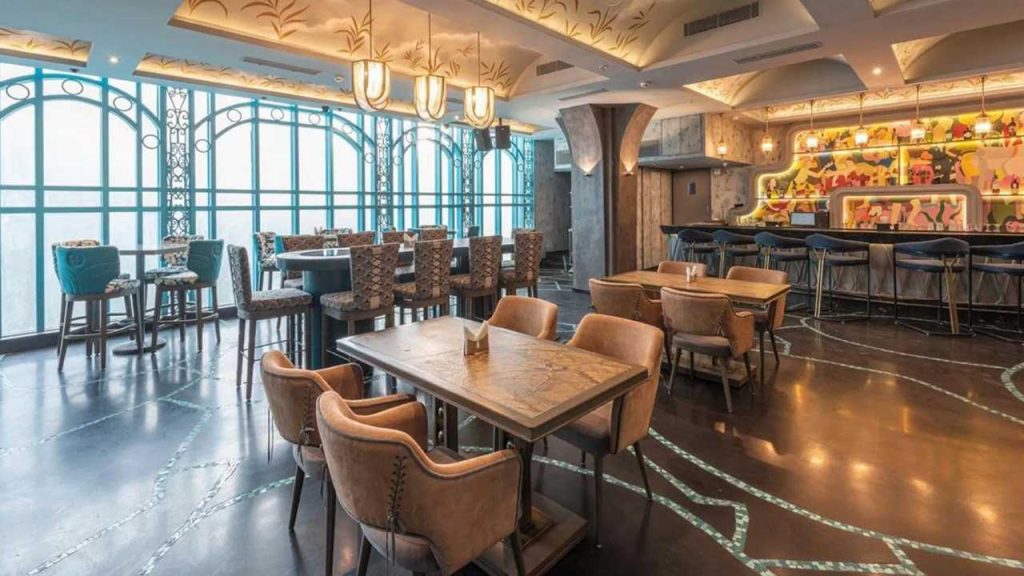Beyond the Menu: How Interior Design Influences Guest Experience and Revenue
When we think about dining out, the first thing that comes to mind is often the food. However, the ambiance of a restaurant plays an equally critical role in shaping the overall guest experience. Interior design goes beyond aesthetics—it influences how customers feel, how long they stay, and how much they spend. In this blog post, we’ll explore how thoughtful interior design can elevate guest satisfaction, boost revenue, and create a memorable dining experience.

The Power of First Impressions: Why Interior Design Matters
From the moment guests step into a restaurant, they form an impression. The interior design sets the tone for their entire experience. A well-designed space not only attracts customers but also encourages them to stay longer and return in the future.
For instance, a cozy, inviting atmosphere can make diners feel comfortable, while a sleek, modern design might appeal to a younger, trendier crowd. The key is to align the design with the restaurant’s brand identity and target audience.
Creating an Emotional Connection Through Design
Interior design has the power to evoke emotions. Warm lighting, soft textures, and earthy tones can create a sense of comfort and relaxation. On the other hand, bold colors, dynamic patterns, and innovative layouts can energize and excite guests.
By understanding color psychology and its impact on mood, restaurateurs can craft spaces that resonate with their customers. For example, blue tones are often associated with calmness, while red can stimulate appetite and conversation.
Optimizing Space for Comfort and Functionality
Space optimization is a critical aspect of restaurant design. Crowded or poorly arranged seating can make guests feel uncomfortable, leading to shorter visits and lower spending. On the flip side, a well-planned layout ensures smooth traffic flow, easy navigation, and a sense of privacy.
Consider using modular furniture that can be rearranged to accommodate different group sizes. This flexibility not only enhances the guest experience but also maximizes seating capacity during peak hours.
Lighting Design: Setting the Mood
Lighting is one of the most underrated elements of interior design. It can transform the ambiance of a space, influencing how guests perceive the food, the decor, and even each other.
Dim lighting creates an intimate, romantic atmosphere, perfect for fine dining establishments. Bright, natural light, on the other hand, works well for casual cafes and breakfast spots. Incorporating layered lighting—ambient, task, and accent—allows for greater control over the mood throughout the day.
The Role of Acoustics in Guest Satisfaction
Noise levels can make or break a dining experience. Poor acoustics can lead to frustration, while a well-balanced sound environment encourages conversation and relaxation.
To improve acoustics, consider using sound-absorbing materials like carpets, curtains, and upholstered furniture. Additionally, strategic placement of plants and decorative panels can help reduce noise without compromising on style.
Furniture Selection: Balancing Style and Comfort
The furniture in a restaurant should be both visually appealing and comfortable. Uncomfortable chairs or wobbly tables can detract from the overall experience, no matter how delicious the food is.
When selecting furniture, prioritize durability and ease of maintenance. Materials like leather, metal, and high-quality wood are not only stylish but also long-lasting. Additionally, ensure that the furniture aligns with the restaurant’s theme and enhances the overall aesthetic.
Social Media Appeal: Designing for the Digital Age
In today’s digital age, interior design plays a crucial role in attracting social media attention. Instagram-worthy spaces encourage customers to share photos online, effectively providing free marketing for the restaurant.
Incorporate eye-catching elements like statement walls, unique light fixtures, or artistic installations. These features not only enhance the visual appeal but also create opportunities for user-generated content, boosting the restaurant’s online presence.
Boosting Revenue Through Strategic Design
Interior design directly impacts a restaurant’s bottom line. A well-designed space can increase table turnover rates, encourage higher spending, and foster customer loyalty.
For example, a bar area with comfortable seating and a lively atmosphere can attract patrons who might not be dining but are willing to spend on drinks and appetizers. Similarly, outdoor seating with scenic views can command higher prices and draw in more customers.
Enhancing Customer Retention Through Memorable Experiences
A memorable dining experience goes beyond great food—it’s about creating a lasting impression. Thoughtful interior design can make guests feel valued and appreciated, increasing the likelihood of repeat visits.
Consider adding personal touches like local artwork, custom decor, or interactive elements that reflect the restaurant’s story. These details not only enhance the guest experience but also strengthen the emotional connection between the customer and the brand.
The Long-Term Benefits of Investing in Interior Design
While redesigning a restaurant may require an upfront investment, the long-term benefits far outweigh the costs. A well-designed space can lead to higher customer satisfaction, increased revenue, and a stronger brand identity.
Moreover, a visually appealing and functional restaurant is more likely to attract positive reviews and word-of-mouth referrals, further driving profitability.
Conclusion: Beyond the Menu
Interior design is a powerful tool that goes beyond aesthetics—it shapes the guest experience and influences revenue. By focusing on elements like lighting, acoustics, furniture, and space optimization, restaurateurs can create spaces that delight customers and drive business success.
In a competitive industry, standing out requires more than just great food. It’s about crafting an unforgettable experience that keeps guests coming back for more. So, the next time you think about your restaurant’s success, remember: the menu is just the beginning.